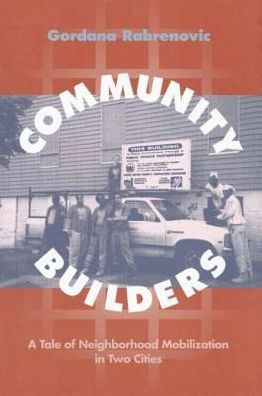Community Builders
In the 1980s the failure of corporate strategies and trickle-down economics led to gross inequalities among many U.S. neighborhoods and cities. By examining and comparing a gentrifying and a low-income neighborhood in two medium-sized cities, Gordana Rabrenovic shows how the problems they faced are typical of a number of neighborhoods nationwide. In particular, Rabrenovic focuses on the relationship between neighborhood associations and urban restructuring, arguing persuasively that the success of neighborhood associations depends more on the city in which the neighborhood is located than on the neighborhood itself. Her tale discusses two very different cities with distinct political economies: Albany, a healthy service sector city, and Schenectady, a declining manufacturing city. Acknowledging both the value and limits of collective action, Rabrenovic addresses issues of particular relevance in urban areas, such as land use and crime, as well as the need for neighborhood organizations to forge links with local elites and other neighborhoods, and to engage and bring together poor and minority residents. Her analysis of neighborhood-based mobilization, preservation, and revitalization illuminates the ways in which grassroots issues intersect with prevailing political agendas and the national economy, as well as how issues such as race and class affect daily community politics.
1103808926
Community Builders
In the 1980s the failure of corporate strategies and trickle-down economics led to gross inequalities among many U.S. neighborhoods and cities. By examining and comparing a gentrifying and a low-income neighborhood in two medium-sized cities, Gordana Rabrenovic shows how the problems they faced are typical of a number of neighborhoods nationwide. In particular, Rabrenovic focuses on the relationship between neighborhood associations and urban restructuring, arguing persuasively that the success of neighborhood associations depends more on the city in which the neighborhood is located than on the neighborhood itself. Her tale discusses two very different cities with distinct political economies: Albany, a healthy service sector city, and Schenectady, a declining manufacturing city. Acknowledging both the value and limits of collective action, Rabrenovic addresses issues of particular relevance in urban areas, such as land use and crime, as well as the need for neighborhood organizations to forge links with local elites and other neighborhoods, and to engage and bring together poor and minority residents. Her analysis of neighborhood-based mobilization, preservation, and revitalization illuminates the ways in which grassroots issues intersect with prevailing political agendas and the national economy, as well as how issues such as race and class affect daily community politics.
30.99
In Stock
5
1

Community Builders
248
Community Builders
248
30.99
In Stock

Product Details
| ISBN-13: | 9781439903476 |
|---|---|
| Publisher: | Temple University Press |
| Publication date: | 04/20/2010 |
| Series: | Conflicts In Urban & Regional |
| Sold by: | Barnes & Noble |
| Format: | eBook |
| Pages: | 248 |
| File size: | 924 KB |
From the B&N Reads Blog
